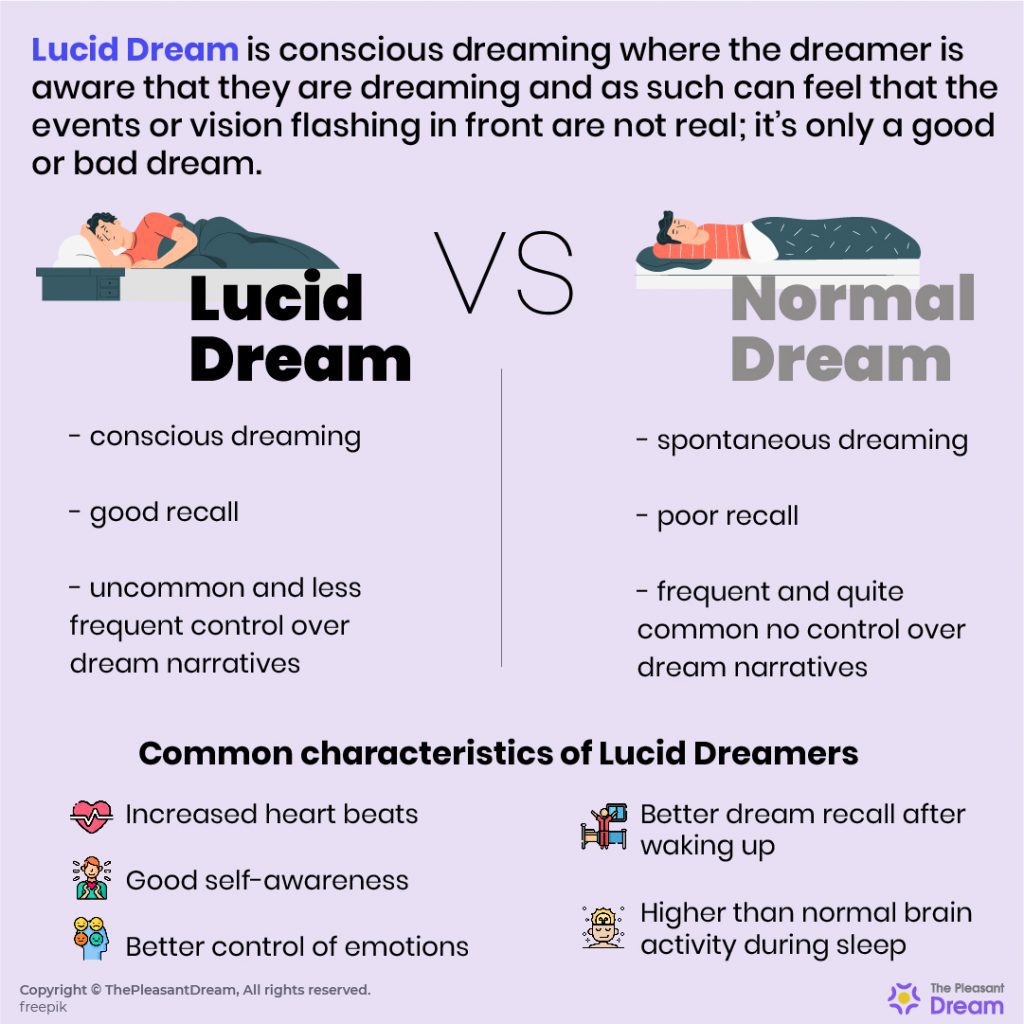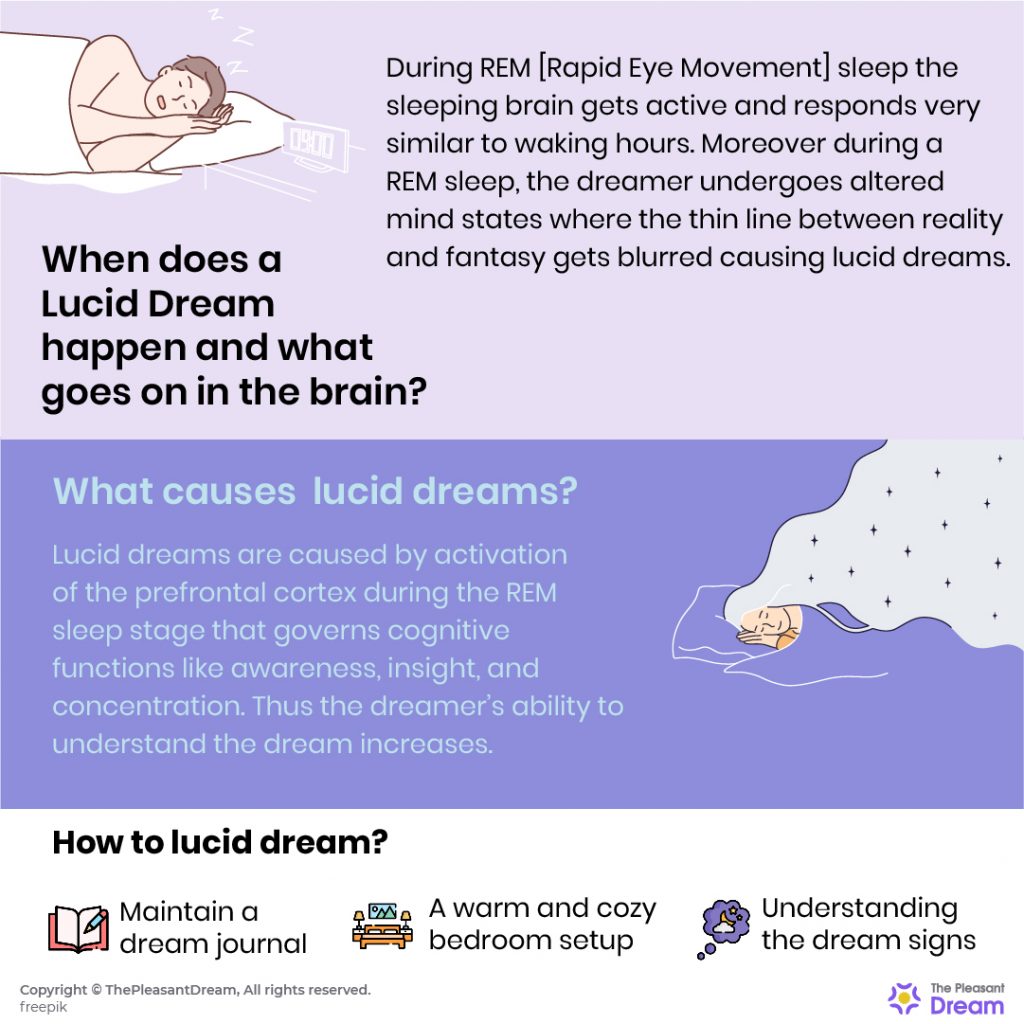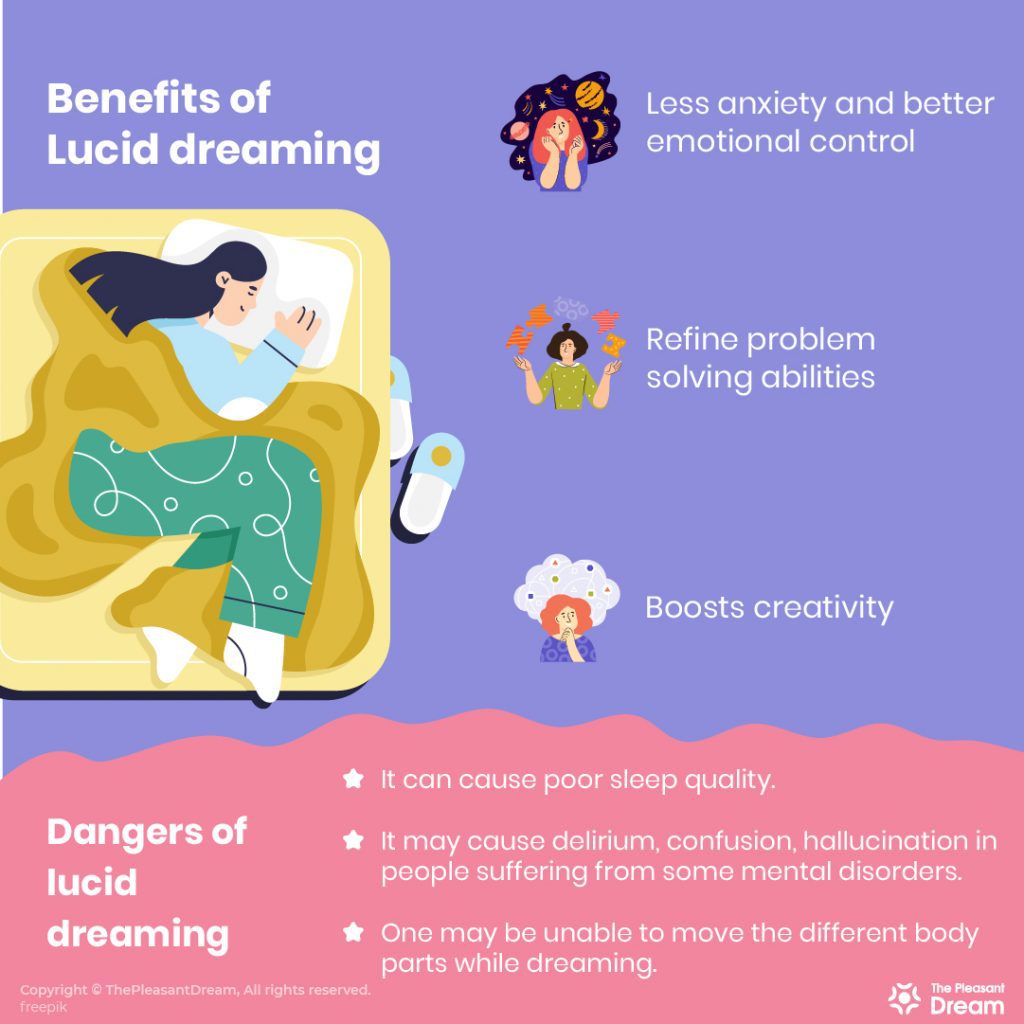The visual images in the lucid dream felt real and you could recall every small detail of it. Scientific studies on sleep and dreaming have proved that this conscious state of dreaming occurs when you are aware and remain mentally agile while dream images keep going
You become a mere onlooker, and a participant in the process of dreaming. Though it sounds weird and absurd, it’s a fact.



What is a Lucid Dream?
SUMMARY
Lucid dreams are conscious dreaming where the dreamer is aware that they are dreaming and as such can feel that the events or vision flashing in front are not real; it’s only a good or bad dream.
In Lucid dreams, you are aware that what you’re seeing as a night vision is just a mere dream. It is not a reality. It means you are aware of your dreams while asleep. This awareness also helps you to control what happens in the dream.
The term lucid dream was first coined by a Dutch psychiatrist and author Frederik Van Eeden in 1913. The term ‘lucid’ means mental clarity, recognition, and awareness. (Green, 1968)
As the person is aware that a dream state is in place, this phenomenon is also referred to as metacognitive mechanism. Metacognition is the individual’s ability to understand, reflect, and report one’s own mental states (Schooler, 2002).
Features of Lucid Dreams
These features were identified by Paul Tholey and are the defining factors for a dream to be considered as lucid dreams. Such as:
- Awareness or being conscious of the dream state
- The dream is vivid and you realized that you’re asleep and already in a fantasy world
- Ability to make decisions about the dream
- Awareness of self
- Being conscious of one’s memory functions
- Ability to understand the details of the dream environment
- Awareness and understanding the meaning of the dream
- The dreamer has a subjective clarity of his/her dream states
- The dreamer has a control of the dream narratives
- Emotions run high during the dream process
When does a lucid dream happen and what goes on in the brain?
Lucid dreams are fascinating because it shows how your conscious mind can take over and gain control over dreams during a physiological state of sleep.
This type of dreaming occurs during REM sleep (Rapid eye movement sleep) when the mind is active and alert like a wakeful state and is marked by eye movements, faster breathing, more brain activity, and loss of muscular movements.
The first REM sleep cycle starts after 90 minutes of falling asleep. Initially it lasts for 10 minutes. Each REM stage that follows next is usually longer. As the brain becomes very active during a REM stage, the regions in the brain responsible for awareness, insight, concentration activates like that of a waking state.
The frontal cortex responsible for memory functioning, emotions, and problem solving also gets active and as such the dreamer’s ability to understand that they are dreaming becomes apparent. (Reference: A 2017 study published in the journal Neuroscience of consciousness, Julian Mutz, 2017)
Common physical characteristics of lucid dreamers
Lucid dreaming brings certain physical changes in the dreamer such as:
- Higher than normal brain activity during sleep
- MRI scans of prefrontal cortex shows increased awareness, conscious about oneself, better memory and cognitive functions
- Lucid dreamers have more gray matter volume that means higher levels of conscious thinking needed for lucid dreaming
Common psychological characteristics of lucid dreamers
- Good self-awareness, ability to understand their individual cognitive processes
- Better control of emotions and behavior while dreaming
- Ability to confront the deepest fears, if any, because of better clarity and brain functioning
What causes lucid dreams?
It still remains unclear the real causes behind lucid dreams though several personal reports of dreamers have indicated increased activity and brain functioning in the REM sleep state causing increased awareness and thereby making such dreams possible.
However, the self-induced lucid dreaming is usually caused due to wish fulfillment, or the need to overcome the deepest fears of the dreamer.
Research findings have also found that lucid dreams are a result of association between prefrontal cortex, parietal cortex, and lateral middle temporal cortex and all these areas get super neural connectivity during the REM sleep causing such dreams to occur.
How to lucid dream? (lucid dreaming techniques)
Though lucid dreaming is not a very common phenomenon, many people experience it spontaneously about once or twice in their lifetime.
But there are few exceptional people who induce lucid dreaming and tune their brain to dream in desirable ways. Lucid dreamers use certain specific techniques to influence their brain to dream about a specific thing.
They train their minds to work in specific ways while sleeping. These people can open up newer and innovative ways to explore the dreams that they see, and even participate in the next course of action that happens in the dream.
It means that dreamers do not passively experience their dream rather they make some effort to test how things actually work in the dream state.
Some of the well-known techniques that can help how to dream lucidly are:
A warm and cozy bedroom setup conducive for dreaming
To get a good sleep ensure that you have a proper space to sleep well and you should follow a good sleep hygiene and schedule as well. You should keep your bedroom quiet, cool, and dark.
Moreover you can use an eye mask to close your eyes, so that no light can get through. Similarly your ears can be plugged in to avoid unnecessary noise.
Before retiring to bed, you can follow a calming bedtime routine such as taking a warm bath, avoiding the use of electronic devices, or even practicing meditation.
Maintain a dream journal
Dream journaling is a good way to analyze the recurring episodes of dreams, symbols and characters present in the dream, narratives, etc.
This method helps you to know your dreams and gives a good indicator of how to lucid dream in the right way the next time you experience it.
Understanding the dream signs
You can review your dream journal records from time to time to recognize the similar patterns of lucid dreams. It will help you to know whether certain themes, people, scenes recur in dreams frequently.
Such a review helps in better understanding of your inner workings, the emotional residues in the unconscious mind that may show up in the dream state.
Reality checks
Reality checks are the various assessment tools that help to analyze whether you’re awake or asleep. These checks are a form of mind training tools that improves metacognition and helps you to notice your consciousness.
You can do reality checks by following certain steps several times throughout the day.
- You can ask yourself by asking “Am I dreaming right now?”
- See around to know whether you are dreaming or not
- Notice your level of awareness closely and engage with your immediate surroundings to know whether you are in a wakeful state or not
Some common reality testing that you may use to lucid dream are:
- Mirrors – Check our reflection and identify the signs of abnormality or distortion, if any
- Solid objects – You can push your hand against a table, wall, or any other hard object and see whether your hand gets into it. If it gets inside, you’re dreaming but if you get hurt due to a big bang, it means you are in a wakeful state
- Time orientation – another reality check can be orienting yourself with time. If you’re dreaming, the time will keep on changing but if you’re awake, the time will change as usual; not in a weird way
- Breathing checks – This is one of the most popular reality checks that is done by closing your nose with fingers and seeing if you can still breathe. IF you are able to breathe normally, it means you ‘re dreaming; and if not then you are in a waking state of awareness
Wake back to bed technique (WBTB)
This popular mild technique of lucid dreaming involves waking up sometime in the night and then returning back to sleep after being awake for a certain amount of time. This induces the probability of lucid dreams by scheduling alarms to increase your chances of getting up during a REM sleep stage.
In this technique you will have to set an alarm 5 to 6 hours after you fall asleep. After the alarm goes off, you will have to stay awake for 30 to 6o minutes.
In this time you are advised to record the dream narratives as much as you remember. Then again go to sleep as usual.
Try going back to sleep again
If you wake up from a dream in the middle of the night, stay in bed and try to fall asleep again. You can write down anything in the dream journal if you want. Then close your eyes and try to sleep again.
Focus on what you were previously seeing and play the dream again in the subconscious. This is a technique commonly used to induce lucid dreams.
Mnemonic induction of lucid dreams (MILD)
LaBerge, 1980 created an lucid dream induction study where an inducing technique known as MILD, meaning Mnemonic induction of lucid dreams was used for the first time. This is the first scientific method used in research done on lucid dreaming.
MILD technique is based on prospective memory that helps you to set an intention of doing something later when the need arises.
Video gaming
A study done in 2006 had shown that video gaming is related with better recall of dreams. The connection has been established on an assumption that video games are usually connected to fictional characters who are seen in a vibrant and dynamic world where the player has some control over the game.
External stimulation
In this technique some external stimuli such as flashing a light alarm is used to induce lucid dreams. You can set it a few hours after you first go to sleep or set it to go off every hour, if you wish.
Like sound and touch stimuli, a light alarm can make the dreamer realize that they were dreaming.
Avoid screen time before falling asleep
You should turn off all electronic gadgets at least an hour before retiring to bed. Make a bedtime routine that is calm and peaceful and helps you relax.
A relaxed body means relaxed mind and this increases melatonin (sleep hormone) that helps you to sleep well.
Benefits of Lucid dreaming (powerful strengths to reckon)
In waking life, lucid dreams are found to have many benefits. They have therapeutic effects. Few of them are discussed here:
- Less anxiety and better emotional control
- Improves motor skills
- Refine problem solving abilities
- Dispel phobias and anxiousness
- Boosts creativity
- Healing
- Self introspection
- Intuition
- Amusing and funny
- Self development tool
Dangers of lucid dreaming
There are certain disadvantages of frequent lucid dreaming that need to be taken care of to reap its benefits. Some of them are as follows:
- Lucid dreaming can cause poor sleep quality and other sleep problems.
- Sometimes people may feel stuck in their lucid dreams and may find it difficult to wake up, but the truth of the fact is this is just a myth.
- The most common downside of lucid dreaming as reported by patients is sleep paralysis. It is the inability to move the different body parts while dreaming.
- Just like any other dreams, lucid dreaming can also have a fear element connected with it, but the experience is less frightening because the dreamer knows how to control the emotions.
- Emotions run high during lucid dreams in varying degrees
- People suffering from psychotic disorders like schizophrenia or Bipolar disorders, or acute depression should avoid lucid dreaming because they forget the thin line between reality and imagination.
How to stop lucid dreaming?
Though many people want to experience lucid dreaming, it’s not always that easy. When you experience intense sensations during a spontaneous dream process, you may find it a little uncomfortable and would prefer to stop it from happening again.
Sleep on your sides
Many of you must have noticed that you get lucid dreams with strange visions if you sleep on your back. It happens because lucid dreaming is related to an out of body experience.
Moreover, sleeping on the sides also helps to avoid sleep paralysis. However if sleep paralysis strikes in, stay calm and remind yourself that this will pass soon and you are just dreaming.
Develop a proper sleep schedule
Lucid dreamers go through sleep disturbances because they get up so many times during the night.
You can stop the recurrence of such dreams by following a proper schedule. Reset your sleep schedule by going to bed at a particular time and waking up at the same time. This will indeed stop the lucid dreams to a great extent.
Avoid caffeine, alcohol
Alcohol and caffeine are sleep inhibitors. These substances can mess up with your sleep schedule causing frequent wakeups.
Sleep meditation
Practice sleep meditation to calm down your senses and get rid of negative and intrusive thoughts before retiring to bed. This will help you to follow a regular sleep schedule also without waking up in the middle of the night.
Keep away from electronic gadgets
Refrain yourself from watching videos or listening to any audio cover before going to sleep. Keep yourself calm and in a peaceful state of mind, so that the frequency of lucid dreams can be reduced.
How to wake up from lucid dreams?
Some tried and tested ways to wake up from your lucid dreams are:
- Call out someone for help by yelling or screaming in dreams. It signals your brain that it’s time to wake up. Sometimes this also wakes you up in reality
- If you know that it’s just a dream, however uncomfortable it may be, try continue with your sleep as usual, so that you get up at the right time
- Repeated blinking of eyes while you’re aware in your dreams can actually wake you up
Myths of lucid dreaming
There are few myths attached with lucid dreams that need to be debunked to clear away the mysteries surrounding the actual phenomenon.
- One can dream lucidly all night long
- You may feel stuck in your dreams and cannot come out of it
- Lucid dreams are not real
- A spiritual person gets more lucid dreams
- Lucid dreams can be fully controlled
- Lucid dreams are risky
Is lucid dreaming real?
Though it may sound weird and crazy, lucid dreams are real. Several empirical findings have suggested that lucid dreams are possible and the dreamer can actively participate in the process of dreaming.
Summing Up from ‘ThePleasantDream’
Lucid dreams goes little beyond normal dreaming as it allows the dreamer to navigate through the process of dreaming and remember the snippets of the dream theme as clearly as possible.
It can be used as a therapy and treat conditions related to PTSD (Post traumatic stress disorder) and anxiety. You may try different techniques to induce such a fascinating experience but beware of its downside as well.

